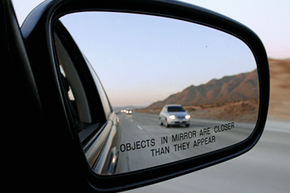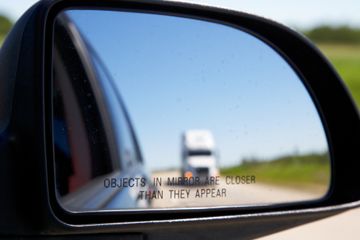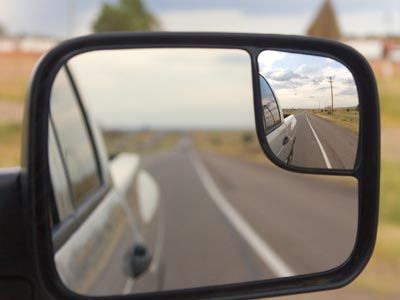If rays of light are carrying the image of a car in a mirror, and those rays travel outward before hitting your eye, the car that reaches your eye is not exactly the same as the car that reflected the light.
To be more specific, it's not in the exact same location. To our eye, the image carried in light reflected from a curved surface (actually any surface, curved or not) appears to be located where those light waves intersect. This is the focal point. Diverging light waves, however, would only intersect if they were to continue through the mirror, to the other side. This means the image of the car seems to be located behind the mirror, at a greater distance from your eye.
The images reflected in a convex mirror, then, look smaller than they are — they're compressed. This is why convex mirrors are used on cars: They reflect more in a smaller space. In other words, a convex mirror has a wider field of view than a flat one, which can only reflect the area right in front of it. With a wider field of view, the driver has more information about the area to the right of the car.
This is the safety trade-off. A convex mirror sacrifices accurate distance perception for a wider field of view. And a wider field of view means a much smaller blind spot than you have on the driver's side of the car.
To avoid image distortion on the driver's side, U.S. regulations require driver's side mirrors to be flat [source: Taub]. Unfortunately, because flat mirrors have a very narrow field of view, there is a substantial area next to the car that they don't reflect. Elsewhere, such as in Europe, large blind spots can be avoided, because regulations allow both side-view mirrors to be convex [source: Taub]. Two wide-angle mirrors can cover a whole lot of (slightly distorted) space.
The current trade-off may not be the end of it, though. In May 2012, a Drexel University math professor patented a mirror that is slightly, calculatedly curved to reflect a wider field of view with less distortion [source: PHYS]. It's convex, yes; but objects in that mirror are about as close as they appear.
Whether this mirror is widely adopted and, if it is, whether it's required to carry the warning/disclaimer we've come to know and love, remains to be seen.
For more information on curved mirrors, driver safety, and related topics, check out the links that follow.



